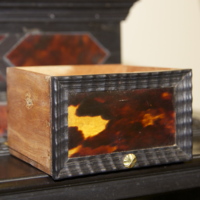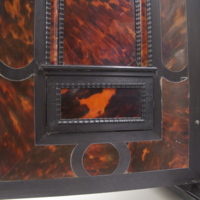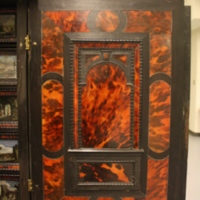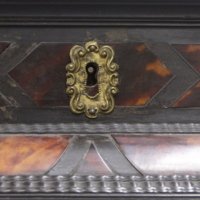Tortoiseshell
Arguably the most impressive feature, the tortoiseshell veneer wraps around the first set of doors like the flames of a fire. To create such an illusion, artisans would paint the veneered surface before applying the tortoiseshell, taking advantage of its natural translucency. The high price of tortoiseshell meant the material was never wasted, and since the material is thermoplastic, it was possible to melt smaller pieces together. This process however, caused the material to lose translucency. There are signs of repairs made to this Kunstkast, mostly noticeble in areas where the tortoiseshell has warped and detached because of humidity or some other environmental cause.
Used for everything from food to ornament, the tortoise has been exploited for thousands of years. Although, it wasn’t until maritime trade began to pick up in the late fifteenth century that the tortoise came to be widely used for furniture application such as on this Kunstkast. Now considered critically endangered, the Hawksbill sea turtle was the species most widely used for these purposes. To sailors, the tortoise provided a tasty source of sustenance for long voyages as well as a source of capital.
The tortoise is a creature that seems almost mythical. With few natural predators, and a lifespan of a century or more, the tortoise has acquired various meanings in many cultures. In some parts of the world the tortoise is a symbol of stability on the one hand and mystery on the other. Its presence was well established (nearly two million years) before the arrival of early humans, and because its native habitats are worldwide, it has enjoyed universal recognition.



